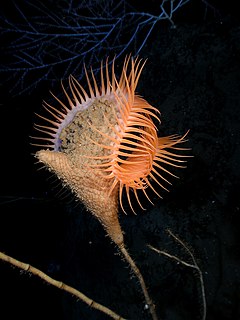
The starlet sea anemone is a species of small sea anemone in the family Edwardsiidae native to the east coast of the United States, with introduced populations along the coast of southeast England and the west coast of the United States. Populations have also been located in Nova Scotia, Canada. This sea anemone is found in the shallow brackish water of coastal lagoons and salt marshes where its slender column is usually buried in the mud and its tentacles exposed. Its genome has been sequenced and it is cultivated in the laboratory as a model organism, but the IUCN has listed it as being a "Vulnerable species" in the wild.

The Venus flytrap sea anemone is a large sea anemone that superficially resembles a Venus flytrap. It closes its tentacles to capture prey or to protect itself. It is a deep ocean species.

Actinoscyphiidae is a family of sea anemones.

Aiptasia is a genus of a symbiotic cnidarian belonging to the class Anthozoa. Aiptasia is a widely distributed genus of temperate and tropical sea anemones of benthic lifestyle typically found living on mangrove roots and hard substrates. These anemones, as well as many other cnidarian species, often contain symbiotic dinoflagellate unicellular algae of the genus Symbiodinium living inside nutritive cells. The symbionts provide food mainly in the form of lipids and sugars produced from photosynthesis to the host while the hosts provides inorganic nutrients and a constant and protective environment to the algae. Species of Aiptasia are relatively weedy anemones able to withstand a relatively wide range of salinities and other water quality conditions. In the case of A. pallida and A. pulchella, their hardiness coupled with their ability to reproduce very quickly and out-compete other species in culture gives these anemones the status of pest from the perspective of coral reef aquarium hobbyists. These very characteristics make them easy to grow in the laboratory and thus they are extensively used as model organisms for scientific study. In this respect, Aiptasia have contributed a significant amount of knowledge regarding cnidarian biology, especially human understanding of cnidarian-algal symbioses, a biological phenomenon crucial to the survival of corals and coral reef ecosystems. The dependence of coral reefs on the health of the symbiosis is dramatically illustrated by the devastating effects experienced by corals due to the loss of algal symbionts in response to environmental stress, a phenomenon known as coral bleaching.

Sea anemones are the marine, predatory animals of the order Actiniaria. They are named after the anemone, a terrestrial flowering plant, because of the colourful appearance of many. Sea anemones are classified in the phylum Cnidaria, class Anthozoa, subclass Hexacorallia. As cnidarians, sea anemones are related to corals, jellyfish, tube-dwelling anemones, and Hydra. Unlike jellyfish, sea anemones do not have a medusa stage in their life cycle.

Diadumene lineata, the orange-striped green sea anemone, has several morphotypes which have been described multiple times.

Nematostella is a genus of sea anemones in the family Edwardsiidae. Of the three species in the genus, the best known is the starlet sea anemone, which has been extensively studied as a model organism in fields such as genetics, evolution, and ecology. The defining morphological apomorphy of Nematostella is the presence of nematosomes.

Hormathiidae is a family of sea anemones in the class Anthozoa.

Sagartiidae is a family of sea anemones.

Epiactis is a genus of sea anemones in the family Actiniidae. There are about nineteen recognised species and the type species is Epiactis prolifera.
Actinernoidea is a superfamily of sea anemones in the order Actiniaria, Until 2014, this taxon was considered to be a separate suborder of the family Actiniaria.
Anenthemonae is a suborder of sea anemones in the order Actiniaria. It comprises those sea anemones with atypical arrangement of mesenteries for actiniarians.
Nematosomes are multicellular motile bodies found in the gastrovascular cavity of the model sea anemone Nematostella vectensis starlet sea anemone. First described by Stephenson in 1935, nematosomes are the defining apomorphy (synapomorphy) of the genus Nematostella but have received relatively little study. Nematosomes can be observed circulating through the body cavity and tentacle lumen of adult anemones, occasionally coming to rest on the gastrodermis. Nematosomes that are dislodged from rest return to circulation. The lifespan of a single nematosome has not been studied.

Diadumene cincta is a small and delicate, usually orange, sea anemone. It has a smooth slender column and up to 200 long tentacles, and normally grows to a length of up to 35 mm (1.4 in), with a base of 10 mm (0.4 in), but specimens twice this size have been recorded. Diadumene cincta is found in the northeastern Atlantic Ocean.

Actinostolidae is a family of sea anemones in the order Actiniaria. Members of this family are deep sea species, with some occurring at hydrothermal vents.

Diadumene is a genus of sea anemones. It is the only genus in the monotypic family Diadumenidae.
Actinernidae is a family of sea anemones. It contains the following genera and species:
Edwardsia delapiae is a species of sea anemone which is currently only known from its type locality in South-West Ireland.
Aiptasiomorphidae is a family of sea anemones.
Andvakiidae is a family of sea anemones.











